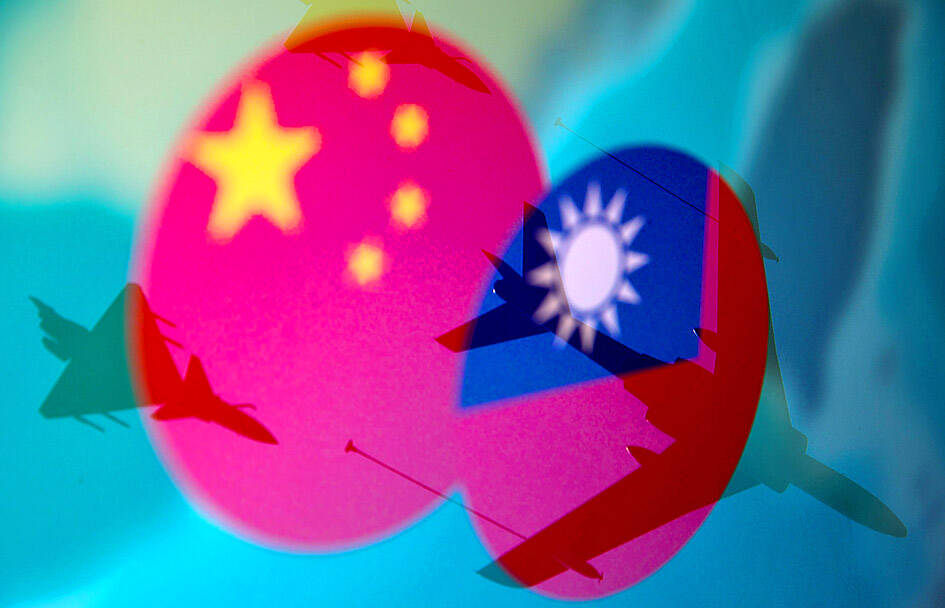There would be clear indications if Beijing were planning to attack Taiwan due to the scale of the preparations required, most of which have not yet been observed, a former CIA analyst said on Monday.
As cross-strait tensions rise, US analysts have been floating a few impending dates for a potential Chinese invasion of Taiwan, ranging from 2027 to as soon as Taiwan’s 2024 presidential election.
However, John Culver, a former analyst and manager of East Asian security, economic and foreign policy at the CIA, said that a full Chinese mobilization would leave “reliable indications” that conflict was coming.

Photo: Reuters
Preparations “almost certainly would not be subtle, at least to the US intelligence community, and probably not to Taiwan and other Western observers,” Culver wrote for the Carnegie Endowment for International Peace think tank.
At least a year before an invasion, production of key munitions would need to ramp up, considering their widespread use in modern warfare, Culver said.
Beijing would also take “visible steps” to protect its economy and military beyond its current limited efforts to achieve self-sufficiency and counter US financial pressure, he wrote.
Shorter-term measures would include stronger cross-border capital controls, rapid repatriation of assets abroad, stockpiling supplies, suspending key exports and more, he said.
If a 2024 attack were planned, Beijing would already be psychologically preparing its citizens for austerity and casualties, but no such measures have been observed, Culver said.
“It seems plausible, therefore, that if the American intelligence community saw some of that happening, they would right now be releasing that information publicly, just as they did almost four months before Russia invaded Ukraine. They would not just be leaking it to one news outlet,” he wrote.
Within the Chinese People’s Liberation Army, a comprehensive stop loss would be implemented six to 12 months in advance of a conflict, followed by a halt to regular training to perform maintenance and expand capacity for resupply and repairs, he said.
Preparations beyond those seen in exercises would intensify in the Eastern and Southern Theater Commands opposite Taiwan, including public blood drives, while troops in other contested regions would need bolstering for fears of chain-reaction warfare, he said.
Then, three to four months before a conflict, a national mobilization would be observed, Culver said.
“These would all be public actions, reported in Chinese national and provincial media and quickly detected by Western government and private analysts,” Culver added.
However, the Chinese Communist Party understands that an invasion would likely be lengthy and damaging, shifting the basis for its legitimacy from economic growth to “near-exclusive focus on nationalism,” he wrote.
A full-scale invasion is also not a given, as Beijing might choose a combination of economic, legal, informational, military and other pressures to force Taiwan to the negotiating table, he said.
Yet if China “decides to fight a war of choice over Taiwan, strategic surprise would be a casualty of the sheer scale of the undertaking,” Culver wrote.
“Any invasion of Taiwan will not be secret for months prior to Beijing’s initiation of hostilities. It would be a national, all-of-regime undertaking for a war potentially lasting years,” he added.

The brilliant blue waters, thick foliage and bucolic atmosphere on this seemingly idyllic archipelago deep in the Pacific Ocean belie the key role it now plays in a titanic geopolitical struggle. Palau is again on the front line as China, and the US and its allies prepare their forces in an intensifying contest for control over the Asia-Pacific region. The democratic nation of just 17,000 people hosts US-controlled airstrips and soon-to-be-completed radar installations that the US military describes as “critical” to monitoring vast swathes of water and airspace. It is also a key piece of the second island chain, a string of

A magnitude 5.9 earthquake that struck about 33km off the coast of Hualien City was the "main shock" in a series of quakes in the area, with aftershocks expected over the next three days, the Central Weather Administration (CWA) said yesterday. Prior to the magnitude 5.9 quake shaking most of Taiwan at 6:53pm yesterday, six other earthquakes stronger than a magnitude of 4, starting with a magnitude 5.5 quake at 6:09pm, occurred in the area. CWA Seismological Center Director Wu Chien-fu (吳健富) confirmed that the quakes were all part of the same series and that the magnitude 5.5 temblor was

Taiwan will now have four additional national holidays after the Legislative Yuan passed an amendment today, which also made Labor Day a national holiday for all sectors. The Chinese Nationalist Party (KMT) and Taiwan People’s Party (TPP) used their majority in the Legislative Yuan to pass the amendment to the Act on Implementing Memorial Days and State Holidays (紀念日及節日實施辦法), which the parties jointly proposed, in its third and final reading today. The legislature passed the bill to amend the act, which is currently enforced administratively, raising it to the legal level. The new legislation recognizes Confucius’ birthday on Sept. 28, the

The Central Weather Administration has issued a heat alert for southeastern Taiwan, warning of temperatures as high as 36°C today, while alerting some coastal areas of strong winds later in the day. Kaohsiung’s Neimen District (內門) and Pingtung County’s Neipu Township (內埔) are under an orange heat alert, which warns of temperatures as high as 36°C for three consecutive days, the CWA said, citing southwest winds. The heat would also extend to Tainan’s Nansi (楠西) and Yujing (玉井) districts, as well as Pingtung’s Gaoshu (高樹), Yanpu (鹽埔) and Majia (瑪家) townships, it said, forecasting highs of up to 36°C in those areas